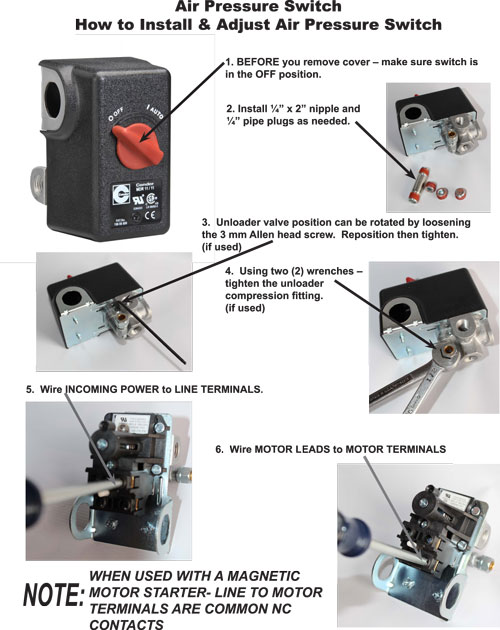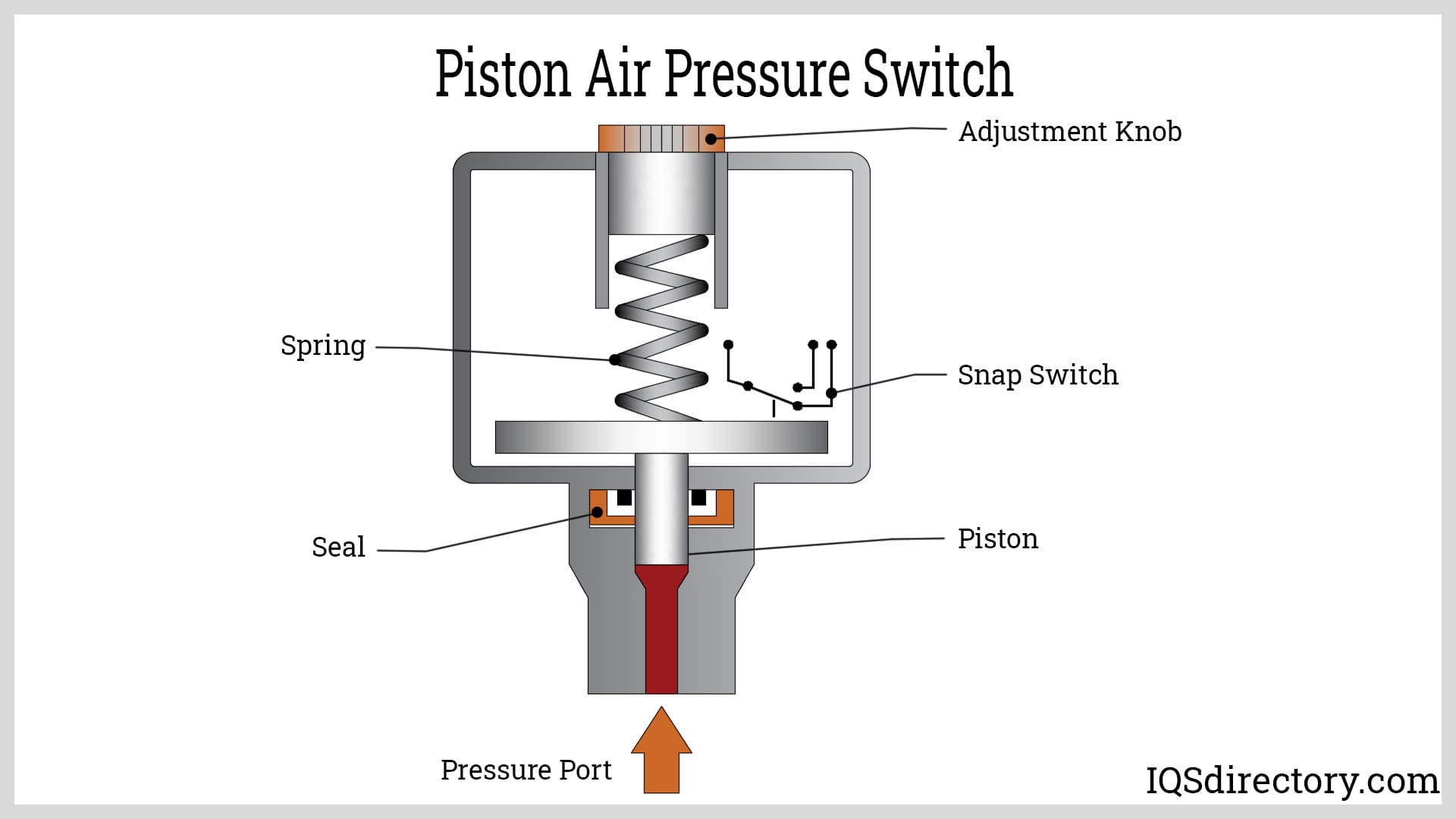An air pressure switch for an air compressor automatically regulates the system’s pressure. It turns the compressor on or off based on preset pressure levels.
Air pressure switches are essential components in air compressors, ensuring optimal performance and safety. They monitor the pressure inside the tank and activate or deactivate the compressor accordingly. By maintaining the desired pressure range, these switches help prevent damage to the compressor and enhance energy efficiency.
Understanding how air pressure switches operate can save time and money on repairs. Regular maintenance of these switches can prolong the life of your air compressor, ensuring it runs smoothly. An effective air pressure switch contributes to the overall reliability and functionality of pneumatic systems in various industrial and home applications.
Introduction To Air Pressure Switches
An air pressure switch is a vital component in air compressors. It helps control the compressor’s operation. Understanding this device is crucial for effective use. Let’s explore its role and basic functions.
Role In Air Compressors
The air pressure switch serves several important roles:
- Monitoring Pressure: It keeps track of air pressure levels.
- Controlling Operation: It turns the compressor on and off.
- Safety Feature: It prevents over-pressurization.
This switch ensures the compressor runs efficiently. It protects the system and maintains performance.
Basic Functions
The basic functions of an air pressure switch include:
- On/Off Control: Activates the compressor at set pressure.
- Pressure Regulation: Maintains desired pressure levels.
- Alarm Indication: Signals when pressure is too high or low.
These functions enhance the compressor’s reliability. Proper settings ensure optimal performance. Regular checks can extend the life of the air compressor.
| Function | Description |
|---|---|
| On/Off Control | Activates compressor at specified pressure. |
| Pressure Regulation | Keeps air pressure within safe limits. |
| Alarm Indication | Alerts for abnormal pressure levels. |

Credit: www.industrialaircompressors.biz
Types Of Air Pressure Switches
Choosing the right air pressure switch is crucial for your air compressor. Different types serve various needs. Understanding these types helps you make an informed choice.
Mechanical Vs. Electronic
Mechanical and electronic switches differ in design and functionality.
- Mechanical Switches
- Uses a diaphragm to detect pressure changes.
- Often more durable and reliable.
- Electronic Switches
- Utilizes sensors for precise readings.
- Offers advanced features like digital displays.
- More sensitive to pressure changes.
Low-pressure Vs. High-pressure Switches
Switches also vary based on pressure levels they manage.
| Type of Switch | Pressure Range | Common Uses |
|---|---|---|
| Low-Pressure Switch | Below 30 PSI | Used in refrigeration systems and HVAC units |
| High-Pressure Switch | Above 30 PSI | Used in industrial air compressors |
Choosing between low and high-pressure switches depends on your application. Ensure the switch matches your compressor’s specifications.
How Air Pressure Switches Work
Understanding how air pressure switches function is essential for efficient air compressor operation. These devices monitor air pressure and control the compressor’s cycling. They ensure optimal performance and safety.
Components And Mechanisms
Air pressure switches consist of several key components:
- Diaphragm: Senses pressure changes.
- Electrical Contacts: Open and close to control power.
- Spring: Resists diaphragm movement.
- Adjustment Screw: Sets the pressure threshold.
The mechanism is simple:
- The diaphragm reacts to air pressure.
- Pressure pushes the diaphragm against the spring.
- Once a set threshold is reached, contacts open or close.
- This action starts or stops the compressor motor.
Pressure Sensing Technology
Pressure sensing technology is crucial for accurate readings. Common types include:
| Type | Description |
|---|---|
| Mechanical Sensors | Use a diaphragm to sense pressure changes. |
| Electronic Sensors | Use transducers to measure pressure electronically. |
| Digital Sensors | Provide precise readings with digital displays. |
Each type has its advantages:
- Mechanical sensors are cost-effective.
- Electronic sensors offer greater accuracy.
- Digital sensors allow for easy monitoring.
By utilizing pressure sensing technology, air pressure switches effectively manage compressor operations.
Selecting The Right Pressure Switch
Choosing the right pressure switch for your air compressor is crucial. The right switch ensures safety and efficiency. A compatible switch enhances the performance of your compressor. Consider these key factors: compatibility, adjustment, and calibration.
Compatibility With Compressor
Not every pressure switch fits every compressor. Ensure compatibility to avoid issues. Here are some important points:
- Voltage Rating: Match the voltage rating of the switch with your compressor.
- Current Rating: Ensure the switch can handle the compressor’s current load.
- Pressure Range: The switch must operate within your compressor’s pressure range.
| Compressor Type | Recommended Pressure Switch |
|---|---|
| Portable Compressors | Low-pressure switch (e.g., 90-125 PSI) |
| Stationary Compressors | Medium-pressure switch (e.g., 100-150 PSI) |
| Heavy-duty Compressors | High-pressure switch (e.g., 150-200 PSI) |
Adjustment And Calibration
Proper adjustment and calibration ensure accurate pressure readings. Follow these steps for optimal performance:
- Read the Manual: Always refer to the manufacturer’s guidelines.
- Locate Adjustment Screws: Identify the adjustment screws on the switch.
- Set the Cut-in Pressure: Adjust the screw for the desired cut-in pressure.
- Set the Cut-out Pressure: Adjust the screw for the desired cut-out pressure.
- Test the System: Run the compressor to check the settings.
Frequent calibration keeps the pressure switch reliable. Check the settings regularly. This practice helps maintain optimal compressor operation.
Installation Process
Installing an air pressure switch for your air compressor is essential. A proper installation ensures safety and efficiency. Follow this detailed guide to complete the installation smoothly.
Step-by-step Guide
- Gather Tools and Materials:
- Adjustable wrench
- Screwdriver
- Pipe thread tape
- New air pressure switch
- Disconnect Power: Always turn off the compressor before starting.
- Remove Old Pressure Switch:
Use the adjustable wrench to loosen the old switch. Be cautious of any residual air pressure.
- Install New Pressure Switch:
Wrap the threads of the new switch with pipe thread tape. This prevents leaks.
Attach the new switch to the compressor. Tighten it securely with the wrench.
- Reconnect Wiring:
Carefully connect the wires to the new switch. Ensure correct polarity.
- Test the Installation:
Reconnect power and turn on the compressor. Check for any leaks.
Common Mistakes To Avoid
| Mistake | Consequence |
|---|---|
| Not turning off power | Risk of electric shock |
| Using old thread tape | Increased chance of leaks |
| Incorrect wire connections | Malfunctioning pressure switch |
| Over-tightening | Damage to the switch or threads |
Avoid these common mistakes for a successful installation. Following the steps carefully leads to better performance. Ensure safety and functionality with a well-installed air pressure switch.

Credit: www.iqsdirectory.com
Maintenance tips
Keeping your air pressure switch in top shape is crucial. Regular maintenance ensures optimal performance. Follow these tips to prolong its lifespan.
Routine Inspection
Inspect your air pressure switch regularly. Look for signs of wear and tear. Check for loose connections and leaks. Use these steps for your inspection:
- Turn off the air compressor.
- Remove the cover of the switch.
- Check the wiring for damage.
- Examine the contacts for corrosion.
- Ensure the pressure settings are correct.
Perform this inspection every three months. This prevents small issues from becoming big problems.
Troubleshooting Common Issues
Sometimes, problems arise with the air pressure switch. Here are common issues and their solutions:
| Issue | Possible Cause | Solution |
|---|---|---|
| Compressor won’t start | Faulty switch | Replace the air pressure switch. |
| Inconsistent pressure | Dirty contacts | Clean or replace contacts. |
| Switch keeps tripping | Overloaded circuit | Check circuit for issues. |
Follow these troubleshooting steps for smooth operation. Address issues promptly to ensure safety and efficiency.
Safety Considerations
Ensuring safety in air compressor operations is crucial. An air pressure switch plays a key role in this. It helps prevent dangerous pressure levels. Understanding safety considerations can save lives and equipment.
Pressure Relief Valves
Pressure relief valves are essential for safety. They release excess pressure automatically. Here are some important points:
- Prevent Overpressure: They stop pressure from exceeding safe limits.
- Automatic Function: They activate without human intervention.
- Regular Checks: Inspect valves regularly for reliability.
Install pressure relief valves in the correct locations. Follow manufacturer guidelines for optimal performance. A well-functioning valve can prevent serious accidents.
Emergency Protocols
Establishing emergency protocols is vital for safety. Clear procedures can minimize risks. Here are some key elements:
- Shut-off Procedures: Know how to quickly turn off the compressor.
- Evacuation Plans: Have a clear escape route in emergencies.
- First Aid Training: Train staff in basic first aid.
- Regular Drills: Conduct safety drills to ensure preparedness.
Document all protocols. Share them with your team. Regular training keeps everyone informed and ready.

Credit: www.amazon.com
Future Innovations
Innovations in air pressure switches for air compressors are exciting. They focus on enhancing efficiency and sustainability. Smart technology and eco-friendly designs lead the way.
Smart Pressure Switches
Smart pressure switches utilize advanced technology. They offer several benefits:
- Real-time monitoring: Users can track pressure levels instantly.
- Remote control: Operate compressors from anywhere via mobile apps.
- Data analytics: Analyze performance trends for better maintenance.
These features help users maintain optimal performance. Smart pressure switches can reduce downtime and save energy.
Eco-friendly Developments
Eco-friendly innovations are crucial in today’s world. Companies focus on sustainable materials and energy efficiency. Some key advancements include:
| Feature | Description |
|---|---|
| Biodegradable materials | Reduce waste and environmental impact. |
| Energy-efficient designs | Lower energy consumption during operation. |
| Recyclable components | Support sustainability by reusing materials. |
These eco-friendly developments help protect the planet. Users gain efficiency while promoting sustainability.
Frequently Asked Questions
What Is An Air Pressure Switch?
An air pressure switch is a device that automatically controls the operation of an air compressor. It monitors the pressure levels and activates or deactivates the compressor based on the set pressure thresholds. This helps maintain optimal pressure and prevents damage to the compressor.
How Does An Air Pressure Switch Work?
The air pressure switch operates by sensing the air pressure within the compressor’s tank. When the pressure reaches a predetermined level, the switch activates or deactivates the compressor. This ensures that the compressor runs efficiently, preventing over-pressurization and ensuring safety.
Why Is An Air Pressure Switch Important?
An air pressure switch is crucial for maintaining safe operating conditions in air compressors. It prevents the compressor from running at unsafe pressure levels, which can lead to equipment damage or failure. Additionally, it enhances the efficiency and longevity of the compressor.
How Do I Adjust My Air Pressure Switch?
To adjust your air pressure switch, first, locate the adjustment screws on the device. Use a screwdriver to turn the screws clockwise or counterclockwise to change the pressure settings. Make sure to test the compressor after adjustments to ensure it operates within the desired pressure range.
Conclusion
Choosing the right air pressure switch for your air compressor is crucial. It ensures optimal performance and safety. Regular maintenance and timely replacements can prevent costly breakdowns. Understanding how these switches function enhances your compressor’s efficiency. Invest in quality components to prolong the lifespan of your equipment and achieve reliable operation.

